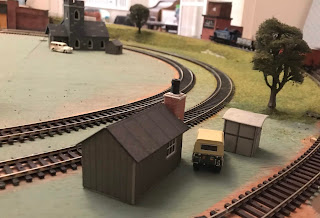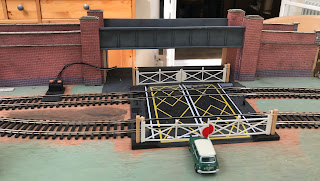Building the model railway is coming along slowly. I never saw it s a weekend job but rather a 3 or 5 year project. Having never done anything like this before, getting a sense of scale is quite difficult. how big are the buildings? What does a bridge look like at 1:76 scale (I'm building in 00 gauge)?
With most of the track down it was time to build something and see what it looked like. Our first building was the signal box. It's made from a pre-cut card kit by
Metcalfe's.
Here it is in its almost finished state. Since this picture was taken I printed a chimney for it and there were two other buildings in the kit, a line side hut and a small shed-like building.
The kits are fairly straightforward to put together although you do need to take your time and separating the parts can be a bit tricky. You need a good sharp modelling knife and a lot of patience.
The next idea was to try something using off cuts of mdf that are lying around in the workshop. The plan with the layout is to include things that connect with the family and with things we've done, places we've lived etc.
Again it's not quite finished, but here's a picture of the progress on my first scratch built model.
I'm waiting for some rusty corrugated panels to arrive in the post for the top section. This is a mixture of bits, some printed some card and some mdf. The brickwork is printed card glued to the main mdf structure. The chute and sliding doors are 3D printed. The aggregate is model railway ballast and the coping around the top of the wall is 3mm thick card.
I've also tried to weather it using acrylic paint. The brush is dipped in the paint and then moist of the paint removed before brushing it randomly along the edges and around the walls.
Once it's finished I'll try and post some better pictures.
My third building was a download kit that you print and then glue to card. It came from
Scalescenes. They have a free kit for you to try so I downloaded that and gave it a go.
Here it is in the foreground. The kit is a more of a challenge than the laser cut kits, but if you make a mistake cutting something out, you can always print another version and try again. It's also now got a chimney courtesy of the 3D printer.
The 3D printer has also been to use for another model. I downloaded a church from
thingiverse. It took nearly 3 days to print, but even then the relative cost when compared to kit was very good.
It was also the first time I've painted something. Not being colour sighted makes painting a challenge, but this was a grey stone building so hopefully I'd be okay!
It's turned out quite nicely. It was primed using a spray primer from Halfords and then painted with the acrylics. The final stage was to use a black wash to give it some depth.

So there you have it. Different ways to create building for the layout. I'm not sure any is better than another, they all have a place. Mixing the forms works well. But that's not unexpected.
I'm currently working on a bridge and I've just built a fish wagon! Pictures to follow!
 The biggest challenge is around the back-to-back points that allow a train to move from one loop the other other. As you can see form this early photo of the layout there are a lot of points in a small area and they are very close to the joins.
The biggest challenge is around the back-to-back points that allow a train to move from one loop the other other. As you can see form this early photo of the layout there are a lot of points in a small area and they are very close to the joins.
















































